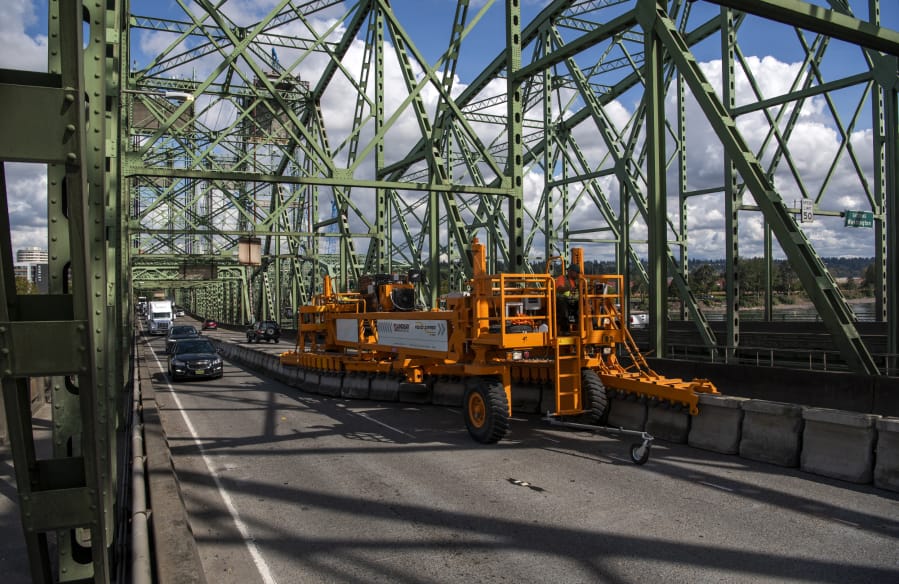The logo on the side of the machine says Road Zipper. Press releases from the Washington and Oregon Departments of Transportation have at various times referred to it as a zipper barrier machine or zipper barrier truck, and one tweet from C-Tran affectionately dubbed it “Zippersaurus.”
Whatever it’s called, the big orange contraption has been one of the most visible parts of the ongoing Interstate 5 Bridge trunnion replacement project, making twice-daily processions along the bridge to realign the barrier between northbound and southbound traffic like some kind of stately freeway Zamboni.
Zipper machines are a common sight for motorists in cities where moveable barriers have become a permanent part of daily traffic management, such as on the Golden Gate Bridge in San Francisco and the Benjamin Franklin Bridge in Philadelphia, but they’re rare in Portland and Vancouver. Many local motorists probably last saw one during a previous I-5 Bridge repair project in 1997.
The northbound span of the I-5 Bridge is closed to all traffic this week while crews replace parts of the lift system. All traffic is sharing the three-lane southbound span, with the middle lane running south in the mornings and north in the evenings to match the direction of rush hour traffic.
A temporary concrete barrier separates the two directions of traffic. But since the middle lane changes direction twice a day, that means the barrier has to change, too — it has to be on the east side of the center lane in the mornings and on the west side in the evenings.
These barriers are heavy, and the temporary bridge barrier is about a mile long from end to end, so scooting the whole thing back and forth twice a day by conventional means would be impractical and disruptive to bridge traffic.
The barrier also has to stay perfectly aligned between the lanes. The claustrophobic design of the I-5 Bridge doesn’t leave room for anything less. There are no shoulders — just a few inches of pavement separate the outer lanes from the concrete barrier at the edge of the road deck.
The zipper machine allows the crews to thread that needle. It can shift the entire barrier in about 20 minutes, keep it correctly aligned, and do it all without disrupting traffic.
The machine looks like a big orange rectangular cart with an arm sticking out of each side and curving to point toward the front and back of the vehicle. Two tracks of small wheels run along the underside the cart in an elongated S-shaped path from one arm to the other, forming a conveyor system.
The specialized barrier on the I-5 Bridge is composed of shorter segments than on a standard Jersey barrier, linked with hinge connectors. The segments all have a wider section along the top, creating a spot where the conveyor system wheels can latch on and lift them slightly up from the roadway.
As the transfer machine drives down the road, the wheels on the front arm grab the barrier segments and feed them through the conveyor system under the machine. The connecting hinges allow the barrier to flex as it passes through. The rear arm places the segments back on the road on the other side of the lane.
The machine begins its noon run at the Vancouver end of the bridge. Crews start by placing a row of orange construction drums across the center lane of I-5 south in Vancouver, directing traffic into the single remaining lane on the right.
Behind the drums, the barrier-mover enters the center lane and drives south over the Columbia River to Hayden Island, which allows it to move through the traffic with minimal disruption and remaining shielded from collisions by the barrier itself.
At any given point in the zipper machine’s journey across the bridge, the center lane in front of it still belongs to southbound traffic. Drivers who pass it on the right are free to jump into the center lane and continue at freeway speeds, immediately racing ahead of the slow-paced zipper-mover.
At the same time, the center lane behind it has become northbound, and northbound drivers who pass to the left of the machine can move over to the center.
In either case, all traffic approaching the zipper machine has already been shunted to the two outer lanes. Vehicles can only enter the center lane once they’ve passed the zipper machine, at which point they’ll always be moving away from it.
Once the job is done, the barrier-mover parks at Hayden Island and waits for the 2 a.m. adjustment, where the whole process is repeated in reverse and it drives back up to Vancouver.




